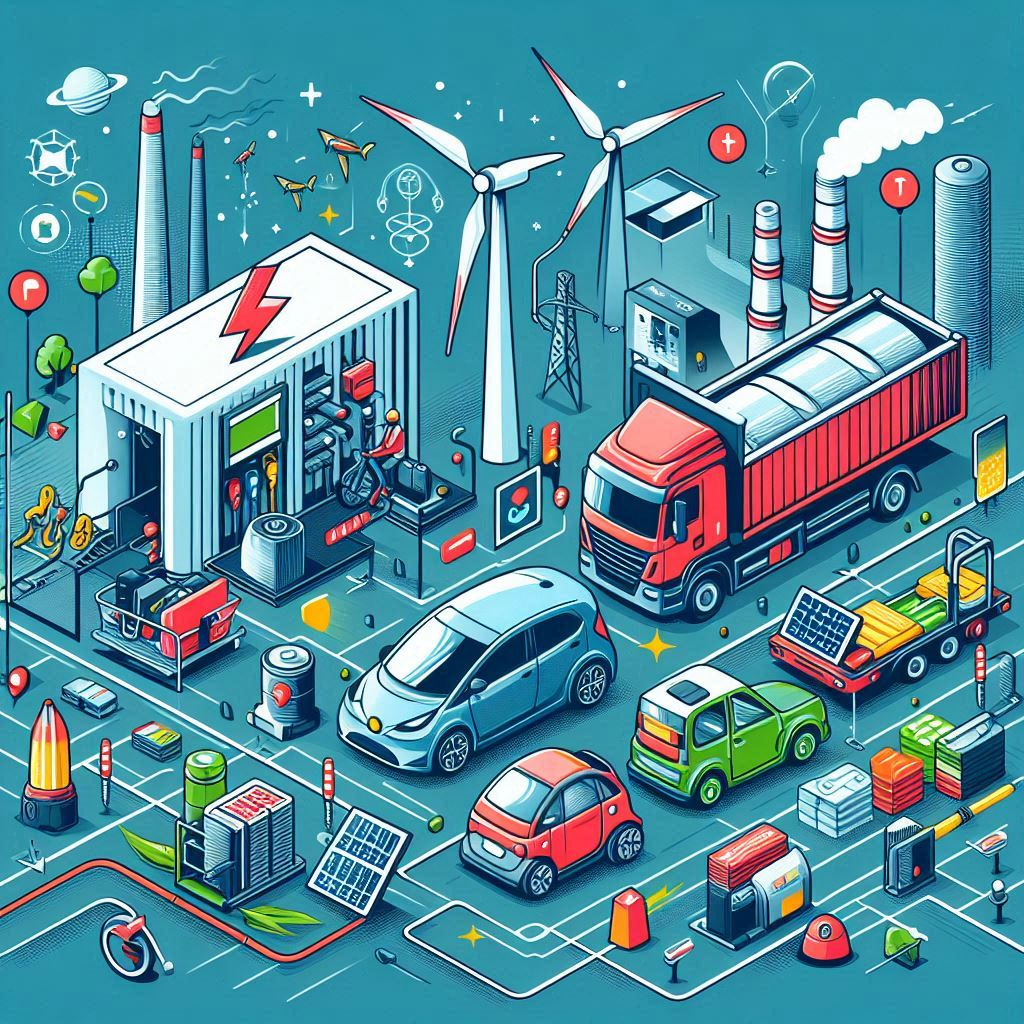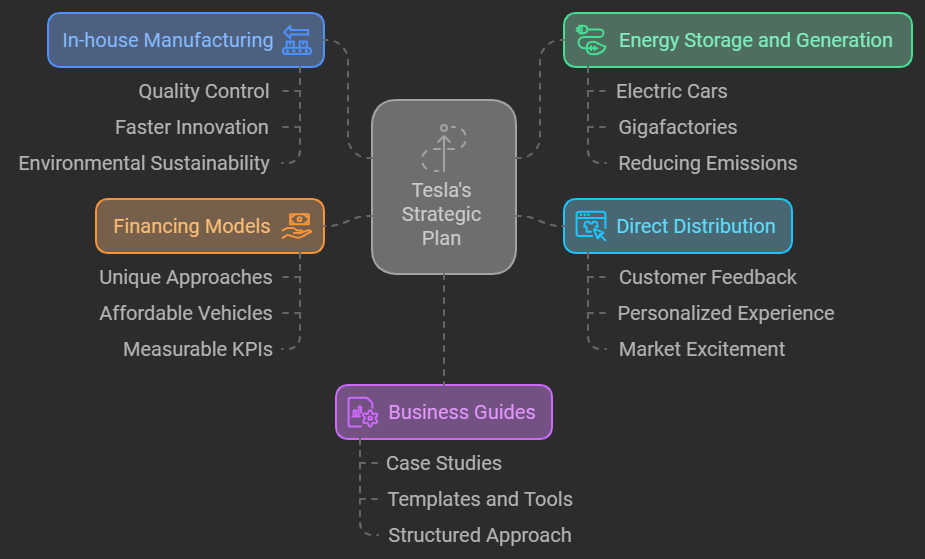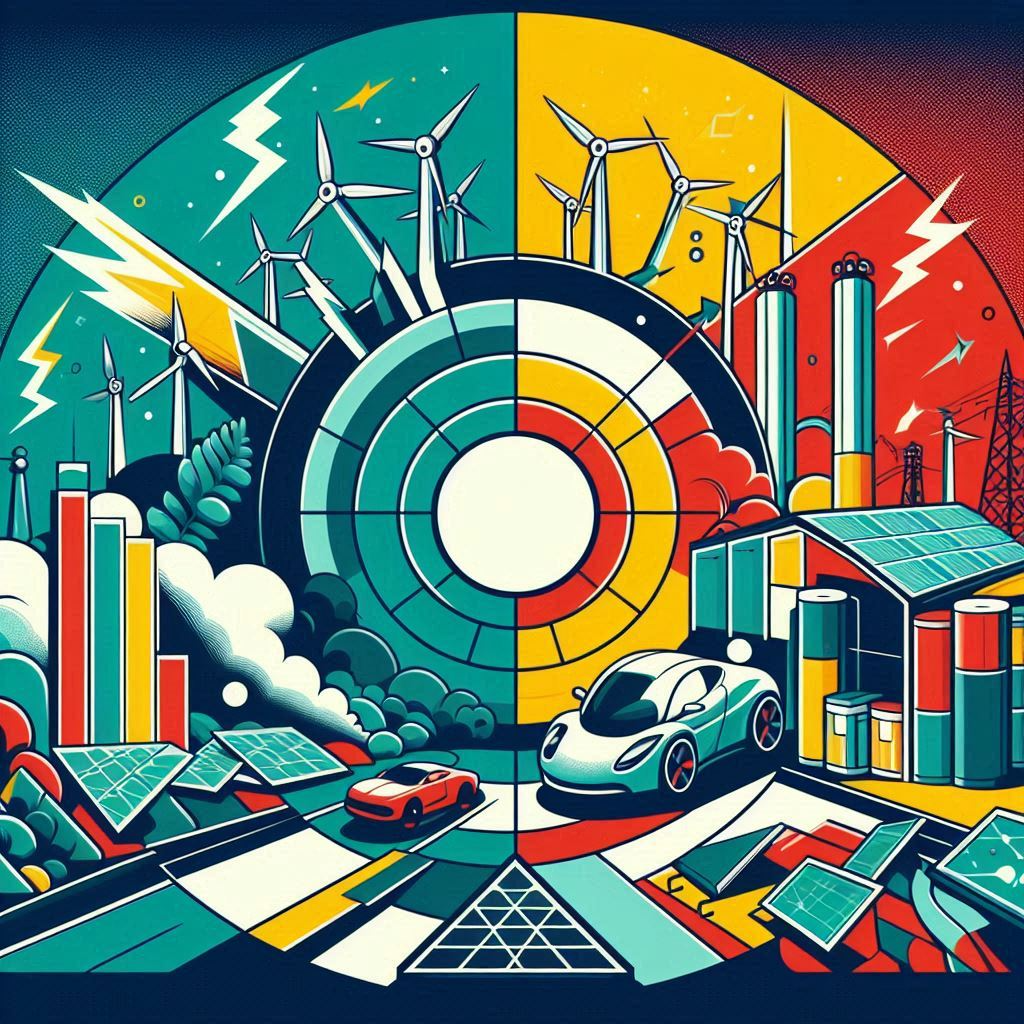Exploring the Strategic Plan of Tesla
Tesla is more than just making advanced cars. It is also shaping the future of sustainable transportation. Let’s explore Tesla’s strategic plan and how it changes the automotive industry. Let’s see what makes Tesla different.
Key Elements of Tesla’s Strategic Plan
What Value Can You Get from Tesla’s Strategy?
Tesla’s strategic plan shows how organizations can achieve faster results. It focuses on disruptive innovation, especially in electric cars. Following Tesla’s approach, organizations can benefit from in-house manufacturing, energy storage, direct distribution channels, and financing models.
Implementing Tesla’s strategies can help businesses innovate, reduce emissions, and support global initiatives like the Paris Agreement. Setting and achieving measurable goals and specific projects can help companies transition to sustainable and customer-focused models.
Tesla’s success is evident in its market value, investment in gigafactories for efficient electric vehicle production, and development of high-performance electric vehicles such as the Tesla Roadster. This innovation has also led to lower insurance premiums for electric vehicles, signaling a market shift towards sustainability.
Organizations can benefit long-term benefits from Tesla’s strategic approach by consistently executing plans and adapting.
What’s Included in the Tesla Strategy Plan Template?
The Tesla Strategy Plan Template includes:
- 3 key focus areas
- 6 specific objectives
- 6 projects for execution
- 6 measurable KPIs
Tesla’s innovation in electric cars can benefit companies by improving their business model for sustainable development and environmental sustainability. This aligns with Tesla’s goal of reducing emissions and promoting the shift from gasoline-powered vehicles.
Organizations can benefit from Tesla’s strategy, such as driving innovation, enhancing market value, and lowering insurance premiums with eco-friendly electric cars. The template is relevant for organizations aiming for success by focusing on customers and sustainability.
By setting clear objectives and measurable KPIs, companies can implement strategic plans effectively, following Tesla’s lead in high performance and innovation in the electric vehicle industry.
Who Is the Tesla Strategy Plan Template For?
The Tesla Strategy Plan Template is a valuable tool for organizations. It helps improve strategic planning and execution processes. Companies in industries such as automotive, renewable energy, and technology can benefit from it.
By following Tesla’s focus on innovation, electric cars, sustainability, and customer-centricity, organizations can innovate, reduce emissions, and increase their market value. The flexible template can be customized based on specific goals, enabling businesses to tailor their strategies to their needs.
Whether a company wants to invest in electric vehicles, create sustainable models, or enhance customer experiences, the Tesla Strategy Plan Template is a great framework. It includes measurable KPIs, clear focus areas, and effective execution strategies.
Following this template can help organizations achieve success and innovation, similar to Tesla’s approach.
How Is the Tesla Strategy Template Relevant to Your Organization?
The Tesla Strategy Template is customizable to fit an organization’s objectives and targets.
This template can adapt to industry needs, promoting innovation, sustainability, and customer focus – key elements of Tesla’s strategy.
Companies using this template may shift towards electric cars and renewable energy, aligning with environmental goals.
Like with the Roadster, Tesla’s focus on market adaptation and disruptive innovation can boost an organization’s market value and success.
Businesses can improve long-term growth and competitiveness strategies by implementing KPIs and focus areas similar to Tesla.
The template guides organizations to replicate Tesla’s success, becoming industry leaders in electric vehicles and sustainable practices.
Define Clear Examples of Your Focus Areas

Tesla’s strategic plan focuses on three key areas:
- Electric vehicle production
- Autonomous driving
- Energy generation and storage.
Specific objectives within these focus areas include:
- Increasing electric vehicle production capacity
- Developing autonomous driving technology
- Enhancing energy storage efficiency.
To achieve these objectives, measurable targets known as KPIs can be set, such as:
- Increasing electric vehicle production by 50%
- Achieving a specific level of autonomous driving capability
- Optimizing energy storage systems by a certain percentage.
Projects to support these KPIs could involve:
- Building new manufacturing facilities in key markets
- Researching advanced autonomous driving algorithms
- Investing in renewable energy sources for improved energy generation.
By focusing on these objectives, setting measurable targets, and implementing related projects, organizations can align with Tesla’s innovation and environmental commitment, fostering success in their business strategies.
Think About the Objectives That Could Fall Under That Focus Area
Specific objectives under the focus area of electric vehicle production in Tesla’s strategy include:
- Increasing production capacity.
- Expanding market share.
These objectives directly contribute to Tesla’s strategy of transitioning towards a solar-electric economy by promoting electric car adoption and reducing emissions.
Challenges in implementing these objectives may include:
- Need for significant investment in manufacturing facilities like gigafactories.
- Ensuring availability of affordable parts for mass production.
Despite challenges, Tesla’s disruptive innovation, seen in the high performance of the Tesla Roadster and its efficiency compared to traditional gasoline cars like the Prius, shows potential for success.
Aligning specific objectives with measurable KPIs and efficient project execution can help organizations follow Tesla’s sustainable business model, drive environmental sustainability, and improve customer centricity.
Using tools like the Cascade Strategy Execution Platform can help execute these objectives and speed up the achievement of strategic goals.
Set Measurable Targets (KPIs) to Tackle the Objective
Specific Key Performance Indicators (KPIs) should be set to measure progress effectively in the Tesla strategy plan. These KPIs relate to electric vehicle production, innovation, and environmental sustainability.
Examples of KPIs could include:
- Increase in electric vehicle production capacity
- Reduction in emissions
- Development of more affordable electric cars
Clear targets should be established to tailor these KPIs for measurement and attainability. For instance, they are increasing electric vehicle production by a certain percentage or reducing insurance premiums for electric car owners.
Strategies to track and monitor these KPIs may involve:
- Regular performance reviews
- Data analysis on market value and stock market trends
- Using tools like the Cascade platform for efficient execution and measurement of the strategic plan
By setting specific and measurable KPIs and implementing effective tracking strategies, organizations can assess plan success, make informed decisions, and work towards long-term success aligned with Tesla’s innovative business model.
Implement Related Projects to Achieve the KPIs
Implementing related projects to achieve the Key Performance Indicators in the Tesla strategic plan involves a focus on disruptive innovation in electric cars.
By developing affordable electric vehicles, organizations can align with Tesla’s goal of reducing emissions and promoting environmental sustainability.
Specific projects could include:
- Investing in Gigafactories for efficient manufacturing of electric cars, as seen in Tesla’s transitional business model.
- Replicating Tesla’s success in high-performance electric vehicles, such as the Tesla Roadster, impacting insurance premiums positively.
Structuring these projects involves a detailed SWOT analysis to address potential challenges and capitalize on opportunities.
Executing these projects requires a customer-centric approach, similar to Tesla’s business strategies, focusing on innovation and measurable results.
By following Tesla’s lead in sustainable practices, companies can strengthen their market value and contribute to the Paris Agreement goals.
Through effective execution and measurable KPIs, organizations can drive success in the electric car market and beyond.
Utilizing the Cascade platform can streamline the implementation process, ensuring alignment with strategic objectives and driving long-term value for the organization.
Utilize Cascade Strategy Execution Platform to See Faster Results from Your Strategy
The Cascade Strategy Execution Platform can help accelerate the implementation of strategic plans focused on disruptive innovation, like Tesla’s shift to electric vehicles.
By using the platform, organizations can:
- Streamline execution processes,
- Track measurable KPIs related to electric car production,
- Adapt strategies in real-time.
Features like project management tools, customizable KPI tracking, and data visualization in Cascade can significantly speed up strategy execution.
Leveraging Cascade can also:
- Optimize strategy execution timelines,
- Ensure alignment of focus areas and projects with business strategies,
- Drive success in transitional business models like Tesla’s commitment to sustainability.
Key Highlights of Tesla’s Strategic Plan

In-house Manufacturing
Implementing in-house manufacturing can benefit companies in several ways. Bringing production in-house allows for better quality control and faster innovation. This approach helps companies like Tesla stay competitive in the market.
For Tesla, using in-house manufacturing for their electric cars, like the Tesla Roadster, supports their goal of creating high-performance vehicles and aligning with environmental sustainability targets. It also helps reduce emissions linked to traditional gasoline cars and supports the Paris Agreement goals.
When deciding between in-house or outsourcing manufacturing, companies should consider factors such as cost-effectiveness, production flexibility, and supply chain management. By opting for in-house manufacturing, organizations can customize their business model to meet market demands, lower insurance costs, and improve stock market performance.
Tesla Energy Storage and Generation

Energy storage and generation are essential parts of Tesla’s plan. Tesla focuses on innovation for electric cars and sustainable energy to reduce emissions and fight global warming, aligning with the Paris Agreement.
The Tesla Roadster, a high-performance sports car, shows innovation and sets a future model for more affordable electric vehicles.
Like Tesla’s batteries, energy storage technology is crucial for environmental sustainability and reducing dependence on natural gas or gasoline cars.
Tesla invests in gigafactories to scale production efficiently and uses financing models, direct distribution, and measurable KPIs for electric vehicle production.
Through customer-centricity and sustainability, Tesla is a leader in the electric vehicle industry, providing an excellent example for other companies.
Direct Distribution
Direct distribution strategies are essential for organizations, especially in industries like electric cars such as Tesla.
Using direct distribution, companies can skip middlemen and go straight to customers. This simplifies the process and creates a more personalized experience for customers.
Tesla’s focus on electric vehicles, like the Tesla Roadster, demonstrates their innovative use of direct distribution.
Selling their sports cars directly to consumers has generated excitement and interest in the market, boosting the company’s value and attracting investments.
This model also lets Tesla receive customer feedback directly, helping them continuously enhance their products and services.
Implementing direct distribution aligns with Tesla’s sustainable and customer-focused approach, promoting success, innovation, and environmental responsibility.
Financing Models
Tesla’s business strategy involves different financing models. The company focuses on unique approaches, from innovation in electric cars to organizational partnerships.
By investing in transitional business models and creating affordable electric vehicles like the Tesla Roadster, Tesla has gained a high market value and reduced emissions.
Organizations seeking to replicate Tesla’s success can adopt similar financing models by prioritizing environmental sustainability and innovation in their business strategies.
Implementing specific KPIs and measurable objectives, like Tesla’s focus on electric vehicle production, can lead to long-term success and customer-centricity.
Tesla’s manufacturing execution, investment in gigafactories, and strategic alignment with the Paris Agreement demonstrate the value of sustainable financing models.
Emphasizing measurable outcomes can help organizations drive success and improve business strategies to address global warming challenges and meet the market demand for electric vehicles.
Business Guides
Business guides provide valuable insights and practical examples for organizations to improve their strategic plans.
Case studies like Tesla’s innovation in electric cars can inspire companies to adjust their business models and stay competitive.
Using templates and tools from these guides can help organizations set measurable objectives, such as reducing emissions or increasing electric vehicle production rates, in line with global initiatives like the Paris Agreement.
Businesses in various industries can benefit from these resources to drive innovation, sustainability, and customer focus.
Following a structured approach similar to Tesla’s strategy can help businesses effectively execute their plans, achieve success, and sustain long-term growth in a competitive and eco-conscious market.

Vizologi is a revolutionary AI-generated business strategy tool that offers its users access to advanced features to create and refine start-up ideas quickly.
It generates limitless business ideas, gains insights on markets and competitors, and automates business plan creation.


